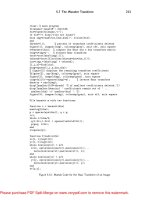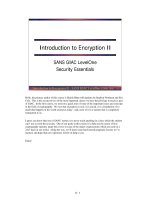INTRODUCTION TO MULTIMEDIA docx
Bạn đang xem bản rút gọn của tài liệu. Xem và tải ngay bản đầy đủ của tài liệu tại đây (1.14 MB, 24 trang )
1
1
INTRODUCTION TO MULTIMEDIA
INTRODUCTION TO MULTIMEDIA
TRƯỜNG ĐH CÔNG NGHIỆP TP. HCM
KHOA CNTT
Giáo viên: Trần Thị Kim Chi
2
2
Cung cấp các kiến thức cơ bản như:
Tạo và làm việc với một Presentation
Những nguyên tắc cơ bản trong tạo, chỉnh sửa, tạo các hiệu ứng cho
Graphics.
Những nguyên tắc cơ bản trong tạo, chỉnh sửa, publishing một
animation và cách làm việc với Video.
Tạo và làm việc với Web Site
Tổ chức, thiết kế, chỉnh sửa và định dạng một Web Site pages
bằng HTML
Tổ chức, thiết kế, chỉnh sửa và định dạng một Web Site pages
bằng DreamWaver
Publish và configure cho trang web trên server
Objectives – Mục tiêu
Objectives – Mục tiêu
3
3
N iộ dung ch ngươ trình
Contents – Nội dung
Contents – Nội dung
TT Nội dung Số tiết
Phân bổ thời gian
Ghi
chú
Lý
thuyết
Thực
hành
Tự
học
1
Introduction
7 2 0 5
2
Presentation Systems
18 3 3 12
3
Graphics
30 6 6 18
4
Animation and Video
27 5 6 16
5
Web Site Development
41 12 15 24
TỔNG
135 30 30 75
4
4
•
Tài liệu học tập:
[1] Multimedia Basic by Suzanne Weixel, Kebbifer Fulton,
Kari Barksdale, Cheryl Morse, and Bryan Morse
[2] Giáo trình Photoshop, Dreamwave và Slide bài giảng
•
Tài liệu tham khảo:
[1] HTML, XHTML and CSS: Visual QuickStart Guide,
Student Edition, Peachpit Press.
[2] The Non-Designer's Web Book (2nd Edition), Peachpit
Press
[3] Patrick Carey, Create web pages with html and dymamic
HTML
[4] Joel Sklar, Principles of Web Design
References – Tham khảo
References – Tham khảo
5
5
Tiêu chu n đánh giáẩ
Kiểm tra và Thi Điểm Tuần
Thi giữa kỳ 20% Theo kế hoạch trường
Thi cuối kỳ 50% Theo kế hoạch trường
Báo cáo tiểu luận 20% Từng phần
Kiểm tra thường xuyên 10% Bất kỳ lúc nào
Yêu cầu đối với sinh viên:
•
Dự lớp: lý thuyết trên 75% , thực hành bắt buộc 100%
•
Bài tập: hoàn thành các bài tập trên lớp và ở nhà.
•
Tham gia đầy đủ các buổi thảo luận của nhóm và
hoàn thành tiểu luận
Evaluation – Đánh giá
Evaluation – Đánh giá
6
6
Trao đ i thông tinổ
Địa chỉ mail:
•
Địa chỉ download tài liệu:
•
/>7
7
Chapter 1: Introduction
What is multimedia?
What is multimedia?
Multimedia Types
Multimedia Types
Applications for Multimedia
Applications for Multimedia
Developing Multimedia Project
Developing Multimedia Project
8
8
What Is Multimedia ?
Multimedia
Multimedia
Multimedia is the integration of text, still and moving
images, and sound by means of computer technology.
Multimedia Systems
Multimedia Systems
Encompass the computer and software systems that are
used in multimedia environments
Interactive control
Distributed multimedia systems
Distributed multimedia systems
Operate over some form of network infrastructure
9
9
The big picture
Image
Image
Text
Text
Speech
Speech
Audio
Audio
Video
Video
Mult ime dia
Mult ime dia
Virtual worlds
Virtual worlds
Streaming video
Streaming video
Web pages
Web pages
Streaming audio
Streaming audio
Client-server
Client-server
Mult ime dia
Mult ime dia
Systems
Systems
Authoring
Authoring
Media asset
Media asset
management
management
Tools
Tools
Frameworks
Frameworks
Network
Network
Distribut e d
Distribut e d
Mul timedia
Mul timedia
Systems
Systems
10
10
Images in Multimedia
Images can be:
•
Drawings
•
Charts
•
Diagrams
•
Paintings
•
Photographs
•
Buttons
•
Animation or video
The big picture
11
11
Sound in Multimedia
Sound, also called audio,
can be:
•
Voice-over or narration
•
Sound effects
•
Music
The big picture
12
12
Video in Multimedia
Video can be:
•
Live
•
Recorded
The big picture
13
13
Multimedia Productions
•
Presentations
•
Tutorials
•
Games
•
Simulations
•
Web pages
What are the types of multimedia
productions
14
14
What are presentations?
Presentations
Presentations are sequences of slides, also
called pages or screens, that usually incorporate
text, sound, graphics, and animation.
Used by:
•
Businesses to present information
•
Teachers or students in classrooms
What are the types of multimedia
productions
15
15
What are tutorials?
Tutorials
Tutorials are computer-
based instructions that
teach skills or
procedures.
Can be used by:
•
Businesses to train their
employees
•
Schools and colleges to
teach or review subject
matter
What are the types of multimedia
productions
16
16
What are simulations?
Simulations
Simulations are computer-based models of real-
life situations.
Can be used for:
•
Training
•
Entertaining
•
Informing
What are the types of multimedia
productions
5
5
1
1
2
2
3
3
4
4
17
17
Games
Games
Can be used for:
•
Entertaining
•
Training
What are the types of multimedia
productions
18
18
Web Pages
Web pages
Can be used for:
•
Entertainment
•
Information
•
Training
•
Reference
•
Research
What are the types of multimedia
productions
19
19
Multimedia Development
Process
Process
Capture from
device
Read from a file
Receive over the
network
Apply effect filters and
transforms
Compress or
decompress
Convert between
formats
Present
Save to a file
Send across the
network
Input
Input
Output
Output
20
20
The Development of
Multimedia
Graphics
•
drawing painting photography digital
photography
Audio
•
speech music recording sound and music
broadcasting
Movies and Television
•
film video digital video
Multimedia Development
21
21
Computer Technology
Computers have
become smaller,
cheaper, and more
powerful.
•
Desktop computers
•
Laptop computers
•
Personal digital assistants
(PDAs)
Multimedia Development
22
22
The Value of Multimedia in Society
Multimedia has become a valuable resource for
education, business, and leisure and recreation.
Education
•
To learn in new and stimulating ways
Business
•
To share resources, deliver information, train employees, and
advertise goods and services
Leisure and Recreation
•
To play video games, surf the Internet, and plan leisure time
Multimedia Applications
23
23
Why Apply Multimedia Technology
Ease of use
Intuitive Interface(giao diện trực giác)
Immersive Experience
Self-Paced Interaction and Better Retention
Better Understanding of the Content
Cost Effectiveness
More Fun = Greater Efficiency
24
24
Summary
Today we have learned about the various aspects of multimedia:
- multimedia data
- multimedia applications
- multimedia development
Multimedia places more demands on the developer and hardware
Multimedia aims to enhance the user’s experience









